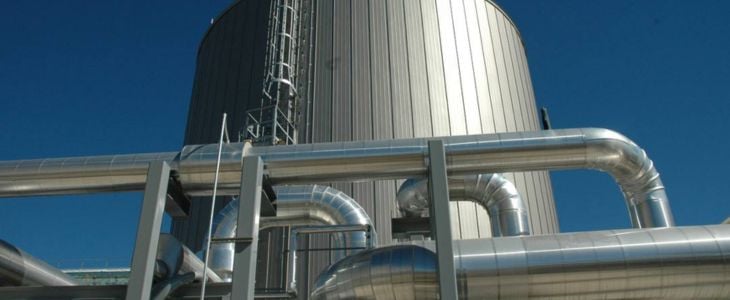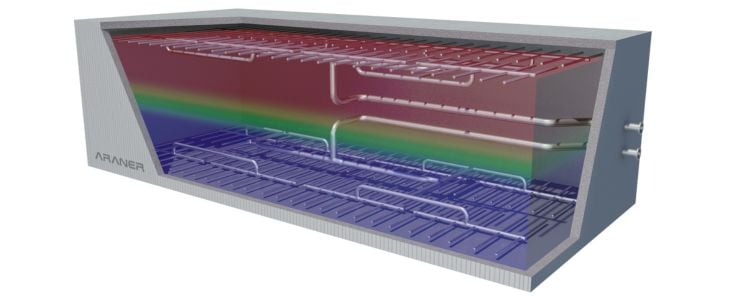The term (and possibilities it entails) seasonal thermal energy storage has been around for decades. In fact, the prospects of seasonal heat storage have been investigated since the 1970s decade in Europe.
However, technology advancements and the recent focus on achieving energy efficiency have translated into a true revival for seasonal thermal energy storage. In fact, the influential IEA report ‘Heating and Cooling Roadmap’ incorporates seasonal thermal energy storage as a must for building energy-efficient systems that are aligned with current and future needs.
This thriving set of technologies has already shown successful uses and structures. Keep reading to find out more about the potential of seasonal heat storage and how these systems are implemented.
What is seasonal thermal energy storage
Seasonal thermal energy storage (often referred to as STES) is a method of storing thermal energy for later use, typically over long time periods (which can go as far as months or even a full year).
Enabled by a series of cutting-edge energy technologies, it involves capturing excess thermal energy during periods of high availability (for instance, solar energy during the summer months) and storing it for later use during periods of high demand.
Another advantage of STES is that when operating at low demand efficiency may decrease, but STES allows to maintain the loads on the optimum performance point in order to keep high efficiency rates.
Seasonal thermal energy storage as a response to current global efforts for sustainability
As we’ve mentioned above, seasonal thermal energy storage is being hailed as an effective way to store and use thermal energy on a large scale.
This has become key in face of current global efforts to reduce reliance on fossil fuels and increase use of renewable energy systems. As such, seasonal heat storage is crucial to integrate certain renewable energy sources.
This is particularly true for solar energy systems, as seasonal thermal energy storage has been shown to extend their possibilities. In fact, the implementation of STES combined with a solar collector facility has been shown to achieve a solar fraction value ranging from 20 to 80% in the long term.(Kalaiselvam, Parameshwaran, 2014).
Other benefits of STES technologies include:
-
Improvement of energy efficiencies and minimizing energy waste
-
Increase of resilience and reliability of energy supply
-
Potential to improve efficiencies in energy systems based on biomass, geothermal energy, waste heat from the industry and combined heat and power plants

How does seasonal thermal energy storage work and how to implement it
Seasonal heat storage begins with the production of excess thermal energy, which can be observed during periods of high availability. It is typically incorporated in projects that involve energy sources such as solar thermal structures, heat pumps or waste heat recovery systems, among others.
The next step involves thermal energy storage technologies. There are several options to capture and store this energy, with TES tanks standing out as a reliable and increasingly efficient solution.
Finally, the STES technologies must be involved in an energy recovery process so that it can be used for its intended purpose. They must also integrate within existing energy systems, including district heating and cooling networks, where energy will be made the most of.
Among these key steps, the choice of tanks remains a crucial part to ensure seasonal thermal energy storage is done the right way.
As such, TES tanks are able to store energy produced during off-peak hours through various configurations, effectively reducing all operational and capital costs and increasing efficiencies.
In such a context, tank energy storage configurations exhibit balanced and better performances when considering technical and economical factors (Tianrun Yang et al., 2021).
There are several options that can be implemented in tanks aiming at seasonal thermal energy storage: the two common techniques include stratified water storage and ice-storage tanks; additionally, these tanks can be built above ground or underground.

Therefore, the choice of STES technologies must be guided by experts in thermal energy engineering who consider the needs and requirements for each project. In fact, seasonal heat storage technologies have associated costs and technical challenges that need to be addressed, such as the need for appropriate storage space, site-specific considerations (for instance, the location’s weather), and system design and operation considerations (such as the expected demand, among other key factors).
All in all, every single circumstance needs to be carefully evaluated for each application regarding seasonal thermal energy storage so that all potential needs and benefits for each project can be met.
At Araner, we help companies devise efficient, cutting-edge sustainable energy projects that match their specific needs and make the most of their potential. Among other thermal energy projects, we design and implement TES tanks as well as implement them into district energy systems.
If you want to find out more about seasonal thermal energy storage and how to implement it into your project, download our thermal energy storage reference ebook for free or get in touch with us to speak directly to our team.










